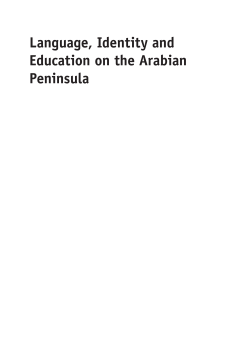
Additional Information
Book Details
Abstract
This collection examines the urban multilingual realities of inhabitants of the Arabian Peninsula in the early 21st century from the perspectives of learners, teachers and researchers. Focusing on both public and private spheres, it considers the importance of both English and immigrants’ languages in a context of rapid socioeconomic development. Extending beyond English–Arabic societal bilingualism, the language practices of the Peninsula’s citizens and residents serve multiple purposes in their daily lived realities. Chapters on home and heritage languages, identity, ELT, commercial signage and academic publishing contribute to a deepening understanding of the inherent linguistic diversity in these dynamic societies.
Language, Identity and Education on the Arabian Peninsula brings together a refreshing variety of methodologies to illuminate how different stakeholders perceive English, Arabic and other languages in relation to their own lives. The rich range of ‘insider’ data in the book and the focus on curricular and social context make a valuable contribution to the literature on this region, with implications for other parts of the world where English is similarly embraced and contested.
[This book] is a welcome addition to the literature on multilingualism, identity and education. It highlights the immense ethnic and linguistic diversity of some Arabian Peninsula countries that have undergone rapid language changes in recent years.
Abderrahman Zouhir, Wayne State University, USA
Bilingualism and multilingualism are evolving linguistic, cultural and especially educational phenomena of the modern day Arabian Peninsula. As rightly put by the editor, this region represents complex and multi-layered societies. In this book the editor and the authors capture these linguistic complexities offering an in-depth analysis of the increasingly powerful position of English in society at large and at universities. The book is a timely work and is applauded for tackling the thorny issues of EMI, identity, language and educational policies.
As the Arabian peninsula continues to globalise and invest in English-medium education, this volume is timely in bringing to light issues of language maintenance and loss, cultural identity, and education relying on sound theories and methodologies and addressing the complexities of the region’s linguistic and cultural contexts. The findings can inform language planning and curriculum design in the area.
Louisa Buckingham lectures at the University of Auckland, New Zealand. Her research interests include sociolinguistics, multilingualism and area studies.
Table of Contents
| Section Title | Page | Action | Price |
|---|---|---|---|
| Contents | v | ||
| Contributors | vii | ||
| Multilingualism in the workplace: English and Bengali | xi | ||
| Introduction | 1 | ||
| Part 1 Multilingualism in Private Spheres and Public Spaces | 11 | ||
| 1 Heritage, Heteroglossia and Home: Multilingualism in Emirati Families | 13 | ||
| 2 Emirati Pre-Service Teachers’ Perspectives of Abu Dhabi’s Rich Linguistic Context | 39 | ||
| 3 Commercial Signs in Oman and Yemen: A Study of Street Advertising in English | 59 | ||
| Part 2 The English Language and Arab Peninsula Identity | 85 | ||
| 4 Emirati Cultural Identity in the Age of ‘Englishisation’: Voices from an Abu Dhabi University | 87 | ||
| 5 A Phenomenological Study of Identity Construction in the Education Sector of Qatar | 116 | ||
| Part 3 Forging Societal Bilingualism Through English Medium Instruction | 137 | ||
| 6 From ‘Late–Late’ to ‘Early–Early’ Immersion: Discontinuities and Dilemmas in Medium of Instruction Policies and Practices | 139 | ||
| 7 Revisiting the Suitability of the IELTS Examination as a Gatekeeper for University Entrance in the UAE | 161 | ||
| 8 English in the United Arab Emirates: Innocuous Lingua Franca or Insidious Cultural Trojan Horse? | 176 | ||
| Part 4The Position of English inTeaching and Research Careers | 197 | ||
| 9 Novice Practitioners’ Views on the Applicability of Postmethod and Critical Pedagogy in Saudi EFL Contexts | 199 | ||
| 10 Between the Covers: A Case Study of Scholarly Journal Publishing in Oman | 220 | ||
| Index | 240 |
